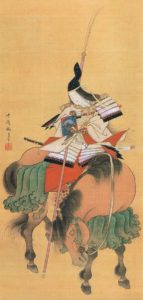
Tomoe Gozen. Drawing by Shitomi Kangetsu (1747–1797). Public Domain.
In this column, I’ll be looking at an inspirational girl from every century, starting in the 21st century and working back to the 1st century CE. As a historian and feminist, I thought this was the perfect way to share the stories of awesome historical girls from around the globe. Hopefully you’ll learn about some girls you might not have otherwise heard about as these Trailblazers deserve to be your next role models!
Following on from the military accolade of my 13th century trailblazer, Mongolian princess and master wrestler Khutulun, I now present to you Tomoe Gozen, her 11th century Japanese counterpart. While many of my medieval trailblazers are chosen for their military bravery and skill, this is largely unintentional. As we delve further into history, this was how many medieval women distinguished themselves from their contemporaries. These women became well-known and respected for showing masculine traits such as bravery and cunning, which separated them from other ‘weak and gentle’ females.
When Tomoe Gozen was born (c.1157 – 1247), women in the Samurai class or betrothed to Samurai’s were trained from childhood to perform their duties as housewives. Yet even this role allowed a fair bit of freedom: they were educated to a good level and were highly literate; they were instructed in the art of writing, painting, tea-ceremony, and managing an estate and servants. They assisted their husband and taught their children. The Samurai class in this period of Japanese history was fairly progressive – Japanese women were allowed access to education and they had an independence that would decline in following centuries. Additionally, it was perfectly common for women in feudal Japan to receive martial arts training. Between the 12th and 19th centuries, women of the Samurai class were taught how to handle a sword, naginata, and a bow and arrow. Nonetheless, the role of female warriors – Onna Bugeisha – was rooted in defence; they were expected to protect themselves and their homes in the event of an enemy attack. Tomoe Gozen is set apart from her fellow warrior women as she was an offensive, rather than defensive, fighter, and a very skilled one at that. She was a strong archer and swordswoman, as well as a master horsewoman.
While there is much variation in the different tales of Tomoe, it is clear that she was one of the best martial arts practitioners of her day and celebrated as a deadly warrior. It is said of Tomoe in The Tale of the Heike, an epic account of the Genpei War:
Tomoe had long black hair and a fair complexion, and her face was very lovely; moreover she was a fearless rider whom neither the fiercest horse nor the roughest ground could dismay, and so dexterously did she handle sword and bow that she was a match for a thousand warriors, and fit to meet either god or devil. Many times had she taken the field, armed at all points, and won matchless renown in encounters with the bravest captains, and so in this last fight (ie the Battle of Awazu, 1184), when all the others had been slain or had fled, among the last seven there rode Tomoe.
This epic description of Tomoe has lived on as legend. Tomoe was undoubtedly a force to be reckoned with – equipped with strong bow and long sword (a male weapon, may I add), sheathed in armor, and charging on horseback to defeat her enemies. Lord Kiso no Yoshinaka was so impressed by her skill as an archer and her courage as a warrior that he appointed her as his leading commander (ippo no taisho) in the Genpei War. She was also most likely one of his concubines, but more importantly his right-hand woman.
Little is known about Tomoe apart from her impressive kill count, uncanny ability to chop of men’s heads in battle and fearsome determination. Although little is known for sure, what is known is enough to have made Tomoe a cultural icon, even in the centuries after her death. By the 15th century, there was a play entitled Tomoe and in the 18th century a Kabuki play called ‘Onna Shibaraku’. Woodblock prints of Tomoe’s exploits on the battlefield were also sold, the early modern version of a magazine cover. Even today, Tomoe is still being re-imagined, appearing in such media as anime, manga – with characters in Usagi Yojimbo, Samurai Deeper Kyo – and video games. Tomoe even has a fantasy book series – The Tomoe Gozen Saga, which portrays Tomoe as the powerful heroine that she was.
Although we don’t know much about Tomoe apart from accounts of her victories in battle, she represents a female resilience and courage that historical records often skips over. She should be celebrated for her refusal to be trained purely for defence and instead letting her true skill as an offensive warrior flourish. The world would certainly be a better place if we all had a dose of Tomoe’s bravery.
-Tia Shah
Junior Girl
Girl Museum Inc.
